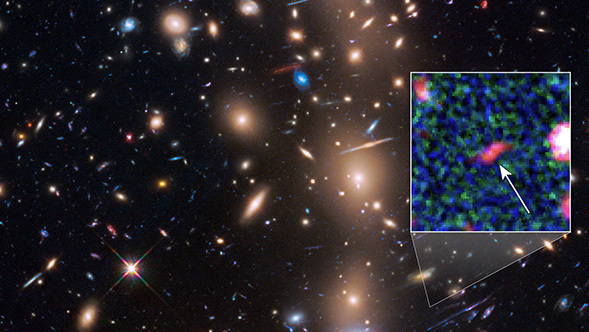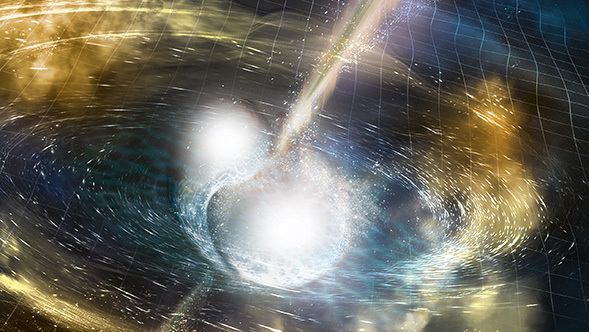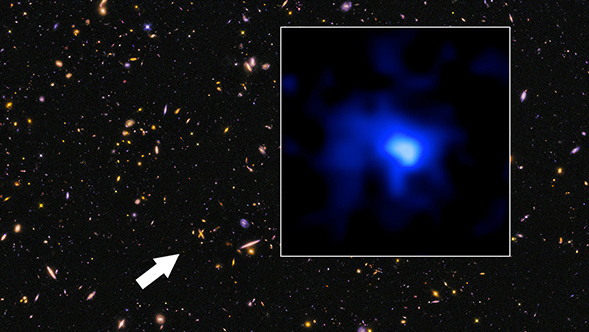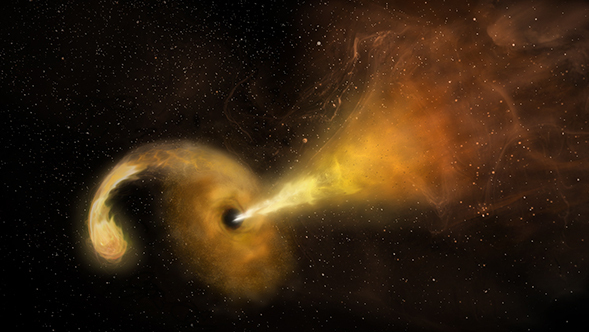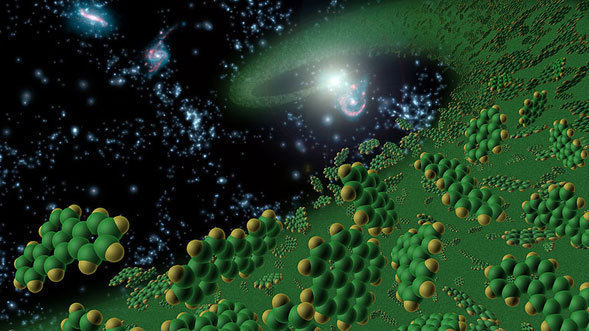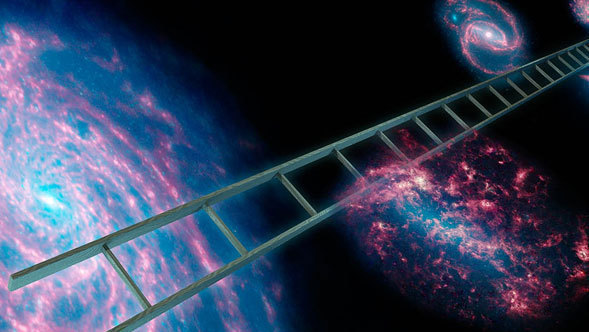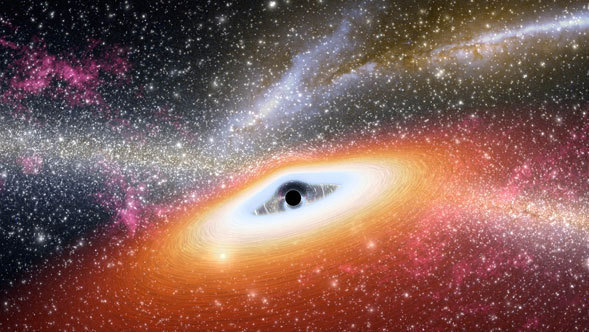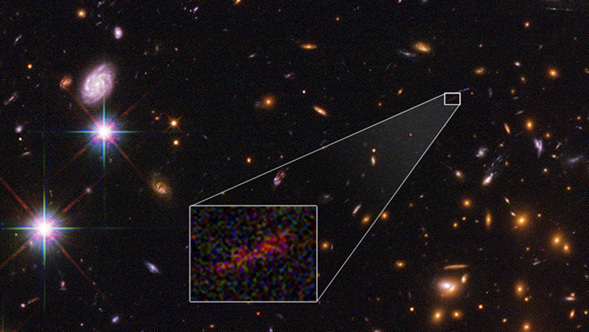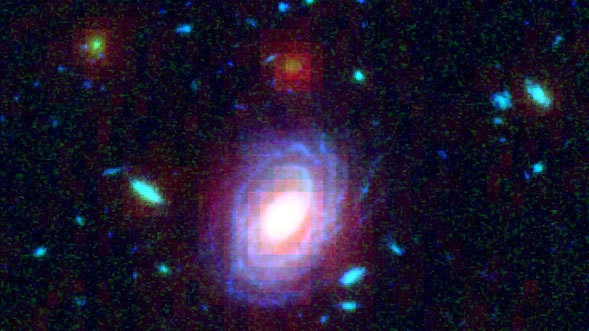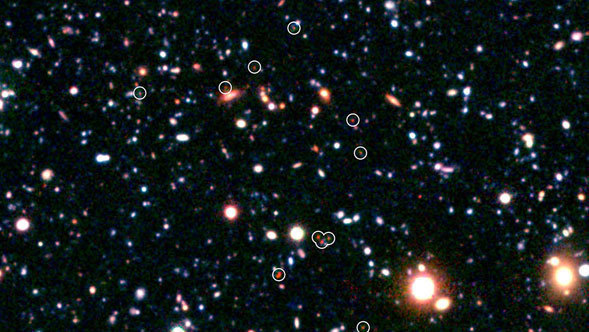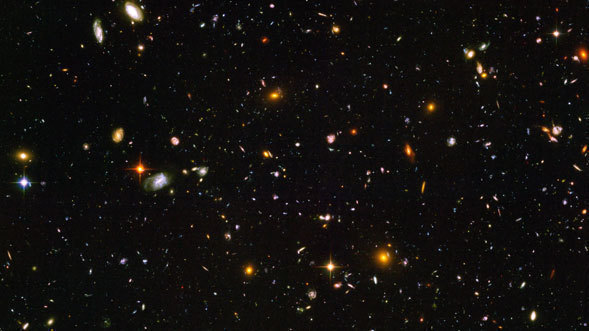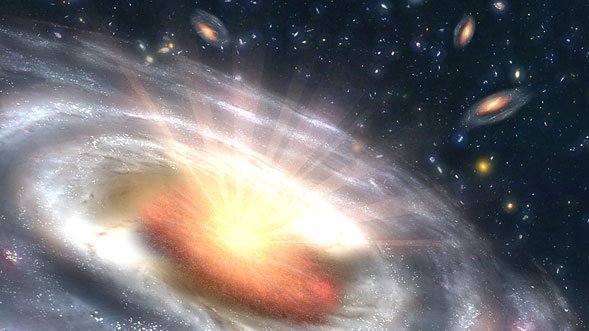In our expanding universe, to look at increasingly distant objects is also like looking back in time to see things as they were billions of years ago. The very expansion of space expands this ancient light, shifting what was once visible to our eyes ever farther into the infrared spectrum. Spitzer was built to give us a way to capture this light from galaxies that formed and grew when the universe was young.
Spitzer has helped to find some of the most distant and ancient galaxies ever detected through their feeble infrared glow. It has also helped us to detect and understand cataclysmic events in distant galaxies connected to the turbulent conditions surrounding the supermassive black holes that lie at their very centers.
Black holes aren't stationary in space; in fact, they can be quite active in their movements. But because they are completely dark and can't be observed directly, they're not easy to study. Scientists have finally figured out the precise timing of a complicated dance between two enormous black holes, revealing hidden details about the physical characteristics of these mysterious cosmic objects.
Astronomers harnessing the combined power of NASA’s Hubble and Spitzer space telescopes have found the faintest object ever seen in the early universe. It existed about 400 million years after the big bang, 13.8 billion years ago.
In just a short amount of time, NASA's Spitzer Space Telescope has bagged thousands of previously unknown dwarf galaxies in a giant cluster of galaxies.
For the first time, NASA scientists have detected light tied to a gravitational-wave event, thanks to two merging neutron stars in the galaxy NGC 4993, located about 130 million light-years from Earth in the constellation Hydra.
An international team of astronomers, led by Yale University and the University of California scientists, pushed back the cosmic frontier of galaxy exploration to a time when the universe was only 5 percent of its present age of 13.8 billion years. The team discovered an exceptionally luminous galaxy more than 13 billion years in the past and determined its exact distance from Earth using the combined data from NASA’s Hubble and Spitzer space telescopes, and the Keck I 10-meter telescope at the W. M. Keck Observatory in Hawaii. These observations confirmed it to be the most distant galaxy currently measured, setting a new record. The galaxy existed so long ago, it appears to be only about 100 million years old.
For the first time, astronomers have directly imaged the formation and expansion of a fast-moving jet of material ejected when the powerful gravity of a supermassive black hole ripped apart a star that wandered too close to the massive monster.
NASA's Spitzer Space Telescope has found the ingredients for life all the way back to a time when the universe was a mere youngster.
Astronomers using NASA's Spitzer Space Telescope have announced one of the most precise measurements yet of the Hubble constant, or the rate at which our universe is stretching apart.
Astronomers have come across what appear to be two of the earliest and most primitive supermassive black holes known. The discovery, based largely on observations from NASA's Spitzer Space Telescope, will provide a better understanding of the roots of our universe, and how the very first black holes, galaxies and stars came to be.
An intensive survey deep into the universe by NASA's Hubble and Spitzer space telescopes has yielded the proverbial needle-in-a-haystack: the farthest galaxy yet seen in an image that has been stretched and amplified by a phenomenon called gravitational lensing.
Two of NASA's Great Observatories, the Spitzer and Hubble Space Telescopes, have teamed up to "weigh" the stars in several distant galaxies. One of these galaxies, among the most distant ever seen, appears to be unusually massive and mature for its place in the young universe.
Astronomers have uncovered a burgeoning galactic metropolis, the most distant known in the early universe. This ancient collection of galaxies presumably grew into a modern galaxy cluster similar to the massive ones seen today.
NASA's Hubble and Spitzer Space Telescopes have joined forces to discover nine of the smallest, faintest, most compact galaxies ever observed in the distant Universe. Blazing with the brilliance of millions of stars, each of the newly discovered galaxies is a hundred to a thousand times smaller than our Milky Way Galaxy.
Astronomers have unmasked hundreds of black holes hiding deep inside dusty galaxies billions of light-years away.
Carnegie Institution of Washington
Balloon-borne Large-Aperture Submillimeter Telescope
Astronomers have discovered a giant gathering of galaxies in a very remote part of the universe, thanks to NASA's Spitzer Space Telescope and Wide-field Infrared Survey Explorer (WISE). The galaxy cluster, located 8.5 billion light-years away, is the most massive structure yet found at such great distances.
Astronomers have discovered a rare beast of a galaxy cluster whose heart is bursting with new stars. The unexpected find, made with the help of NASA's Spitzer and Hubble space telescopes, suggests that behemoth galaxies at the cores of these massive clusters can grow significantly by feeding off gas stolen from another galaxy
A team of Caltech researchers that has spent years searching for the earliest objects in the universe now reports the detection of what may be the most distant galaxy ever found.
Thanks to the unprecedented sensitivity of the telescope at the Atacama Large Millimeter Array (ALMA) in Chile, a Caltech-led team has been able to observe the dust contents of galaxies as seen just 1 billion years after the Big Bang—a time period known as redshift 5-6. These are the earliest average-sized galaxies to ever be directly observed and characterized in this way, thanks in part to observations obtained by NASA's Spitzer Space Telescope.
Our Sun missed the stellar "baby boom" that erupted in our young Milky Way galaxy 10 billion years ago. During that time the Milky Way was churning out stars 30 times faster than it does today. Our galaxy was ablaze with a firestorm of star birth as its rich reservoir of hydrogen gas compressed under gravity, creating myriad stars. But our Sun was not one of them. It was a late "boomer," arising 5 billion years later, when star birth had plunged to a trickle.
A NASA sounding rocket experiment has detected a surprising surplus of infrared light in the dark space between galaxies, a diffuse cosmic glow as bright as all known galaxies combined. The glow is thought to be from orphaned stars flung out of galaxies.
What makes one rose bush blossom with flowers, while another remains barren? Astronomers ask a similar question of galaxies, wondering how some flourish with star formation and others barely bloom.
Astronomers "fishing" for galaxies turn up surprisingly massive catch. In one of the longest surveys the telescope will have ever performed, astronomers have begun a three-month expedition trawling for faint galaxies billions of light-years away.
Astronomers have for the first time caught a glimpse of the earliest stages of massive galaxy construction. The building site, dubbed "Sparky," is a dense galactic core blazing with the light of millions of newborn stars that are forming at a ferocious rate.

